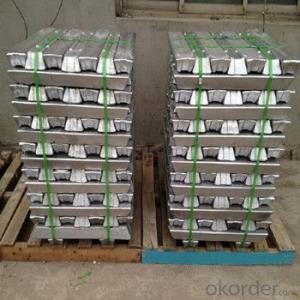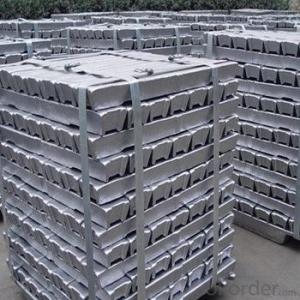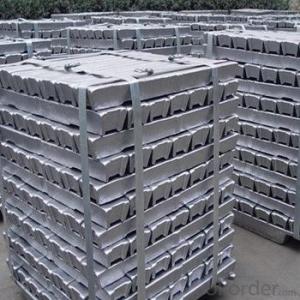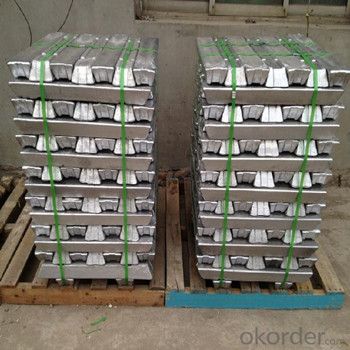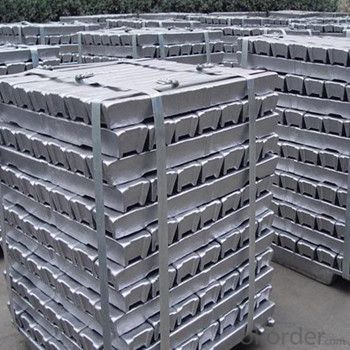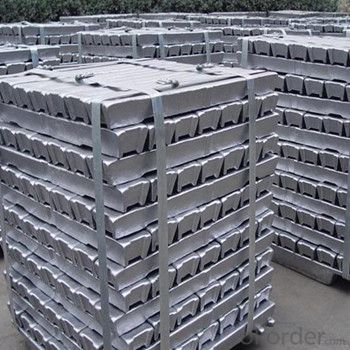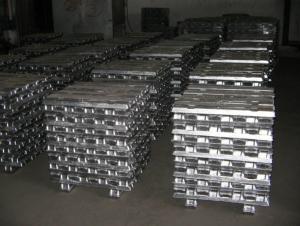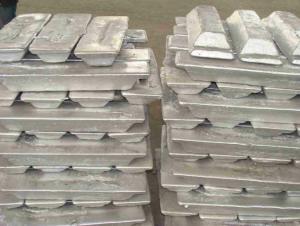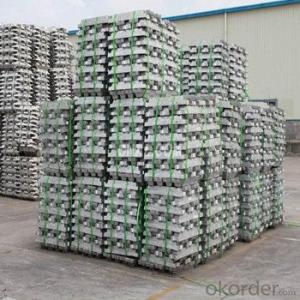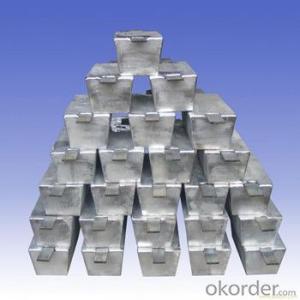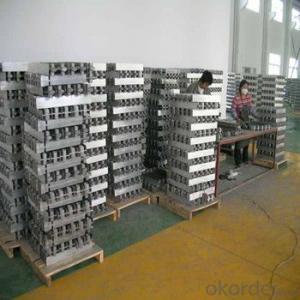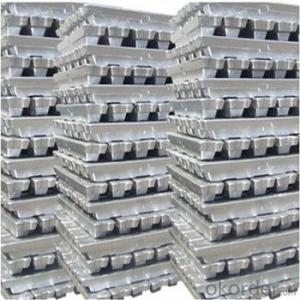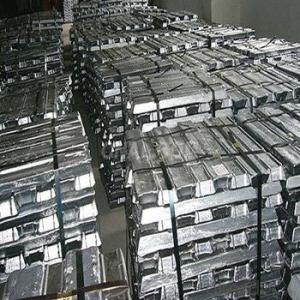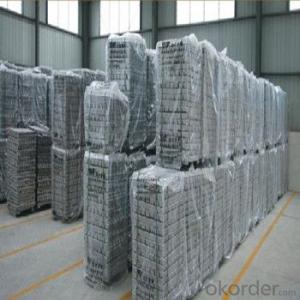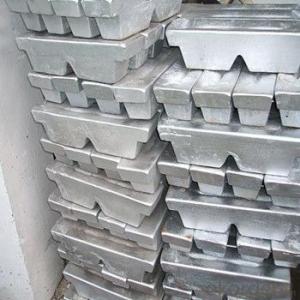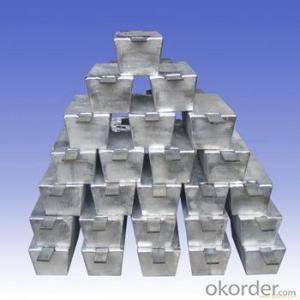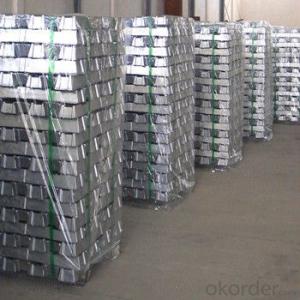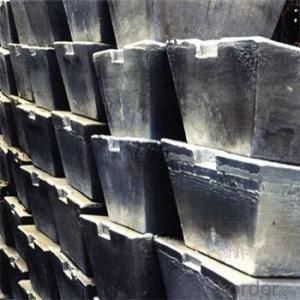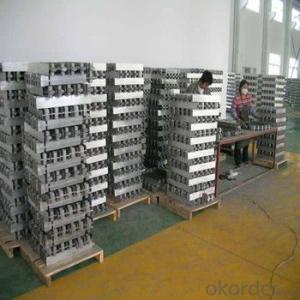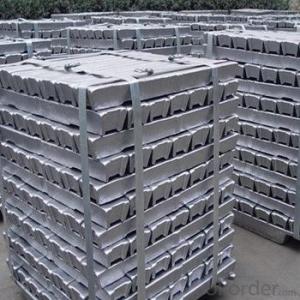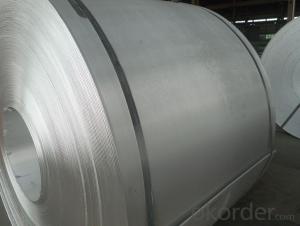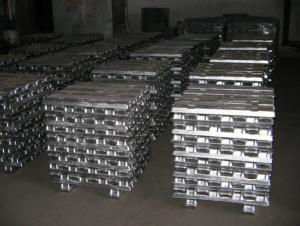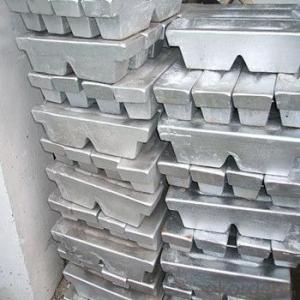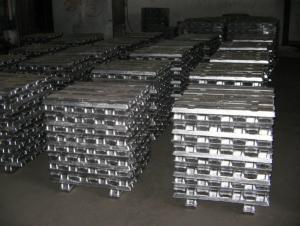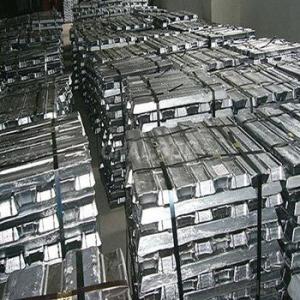Aluminum Pig/Ingot Sold With Low Price From Mills
- Loading Port:
- China main port
- Payment Terms:
- TT OR LC
- Min Order Qty:
- 1000 m.t.
- Supply Capability:
- 100000 m.t./month
OKorder Service Pledge
OKorder Financial Service
You Might Also Like
Pure Aluminum Pig/Ingot Used for Industry
1.Structure of Aluminum Pig/Ingot
A material that has been cast into a shape in order to be transported and processed easier than in an unprocessed form. An ingot is typically rectangular in shape, which allows it to be stacked. Ingots are most commonly associated with metals, with ingots of gold held in the vaults of banks and brokerages being popular images.
Aluminum Ingot is with the AL as the main chemical composition.Aluminum Ingot is used for industry,such as automobile,pinning and weaving,electron broadly and so on. Aluminum Ingot has the following advantages: easy control and operation, fast melting.
2.Main Features of the Aluminum Pig/Ingot
•High Purity
•Easy control and operation
•High strength
•Fast melting
•Competitive price
•Best Service
3.Aluminum Pig/Ingot Images
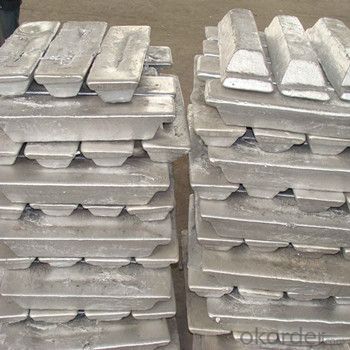
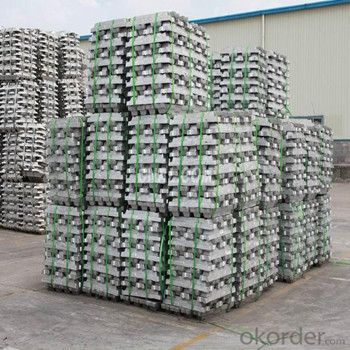
4.Aluminum Pig/Ingot Specification
Grade | Chemical Composition % | |||||||||
Al≥ | impurities ≤ | |||||||||
Si | Fe | Cu | Ga | Mg | Zn | Mn | others | Sum | ||
Al99.9 | 99.90 | 0.50 | 0.07 | 0.005 | 0.02 | 0.01 | 0.025 | - | 0.010 | 0.10 |
Al99.85 | 99.85 | 0.80 | 0.12 | 0.005 | 0.03 | 0.02 | 0.030 | - | 0.015 | 0.15 |
Al99.7 | 99.70 | 0.10 | 0.20 | 0.010 | 0.03 | 0.02 | 0.030 | - | 0.030 | 0.30 |
Al99.6 | 99.60 | 0.16 | 0.25 | 0.010 | 0.03 | 0.03 | 0.030 | - | 0.030 | 0.40 |
Al99.5 | 99.50 | 0.22 | 0.30 | 0.020 | 0.03 | 0.05 | 0.050 | - | 0.030 | 0.50 |
Al99.00 | 99.00 | 0.42 | 0.50 | 0.020 | 0.03 | 0.05 | 0.050 | - | 0.050 | 1.00 |
5.FAQ of Aluminum Pig/Ingot
We have organized several common questions for our clients,may help you sincerely:
①How about your company?
A professional factory which foucs on producing the aluminum pig,can meet customers' requiement to the quality and grade.The quality also have been accepted by customer.Already got the good reputation among the customers.It have gotten lot of much experience.The facrtory has the professional Technical Worker and the advanced equipments for production.Beside,it has the profesional teams to operate the whole proess for exporting.OEM service is availble and welcome.The items have beedn exported around the world,and have been acceptable among the customers,and have gotten the good reputation already.No matter from the quality,price and service,can be guaranteed for the cusgtomers.High purity and diffent grade are available.
②How to guarantee the quality of the products?
We have established the international advanced quality management system,every link from raw material to final product we have strict quality test;We resolutely put an end to unqualified products flowing into the market. At the same time, we will provide necessary follow-up service assurance.
③How long can we receive the prod rking days, We will arrange the factory delivery as soon as possible. The pecific time of receiving is related to the state and position of customers.Commonly 7 to 10 working days can be served.
- Q: How are aluminum ingots used in the production of lighting fixtures?
- Aluminum ingots play a crucial role in the production of lighting fixtures due to their unique properties and versatility. Firstly, aluminum is lightweight yet highly durable, making it an ideal material for manufacturing various components of lighting fixtures, such as the body, base, or frame. Its lightweight nature allows for easier installation and transportation, while its durability ensures the longevity of the fixture. Moreover, aluminum has excellent thermal conductivity, which is essential for lighting fixtures as it helps dissipate heat generated by the bulbs. This property allows the fixture to remain cool and prevents overheating, ensuring the safety and efficiency of the lighting system. In addition, aluminum ingots can be easily molded into different shapes and sizes, enabling the production of intricate and aesthetically pleasing lighting fixtures. This flexibility in design allows manufacturers to create a wide range of styles, from sleek and modern to classic and ornate, catering to various consumer preferences. Furthermore, aluminum is highly corrosion-resistant, which is particularly important for lighting fixtures that may be exposed to outdoor elements or high levels of moisture. This property ensures that the fixture remains intact and maintains its appearance, even under harsh conditions. Lastly, aluminum ingots are also environmentally friendly, as they can be easily recycled and have a low carbon footprint compared to other materials. This makes aluminum an attractive choice for lighting fixture manufacturers who prioritize sustainability and want to reduce their environmental impact. Overall, aluminum ingots are indispensable in the production of lighting fixtures due to their lightweight, durable, and thermally conductive properties, as well as their versatility in design and environmental friendliness.
- Q: How do aluminum ingots contribute to the circular economy?
- Aluminum ingots play a significant role in contributing to the circular economy due to their recyclability and multiple applications. The circular economy is an economic system aimed at minimizing waste and maximizing the value of resources by promoting reuse, recycling, and remanufacturing. One key aspect of aluminum ingots is their recyclability. Aluminum is one of the most recycled materials globally, with a recycling rate of around 70-80%. This means that a large portion of aluminum used in various products can be recycled and transformed into new aluminum ingots. This recycling process requires significantly less energy compared to primary aluminum production, resulting in reduced greenhouse gas emissions and a lower environmental footprint. Moreover, aluminum ingots have numerous applications across various industries, including construction, automotive, aerospace, packaging, and electronics. By using recycled aluminum ingots, these industries can reduce their dependence on virgin (primary) aluminum extraction, which is an energy-intensive process. The use of recycled aluminum ingots not only conserves natural resources but also helps in reducing carbon emissions associated with primary aluminum production. Additionally, the circular economy approach encourages the design and production of products with recyclability in mind. Aluminum ingots can be easily melted down and reshaped into various forms, allowing for the creation of new products while maintaining their quality. This closed-loop system ensures that aluminum remains in circulation, reducing the need for raw material extraction and minimizing waste generation. In conclusion, aluminum ingots contribute to the circular economy by being highly recyclable, enabling the transformation of waste aluminum into valuable resources. Their use in various industries promotes sustainability, reduces energy consumption, and minimizes waste, making aluminum ingots an essential component in the transition to a more circular and resource-efficient economy.
- Q: What kind of aluminum consumption does the furnace compare with natural gas?
- The aluminum loss of the reverberatory furnace is proportional to the melting time: the longer the loss is, the higher the temperature of the flame, the aluminum surface continues to oxidize to alumina powder.
- Q: What are the properties of aluminum ingots that make them suitable for construction?
- Aluminum ingots possess several properties that make them suitable for construction purposes. Firstly, they have a high strength-to-weight ratio, which means they are lightweight yet strong enough to withstand the structural load. This makes them easier to handle and transport during construction projects. Secondly, aluminum ingots have excellent corrosion resistance, making them highly durable and suitable for outdoor applications. Additionally, aluminum is non-magnetic and non-sparking, making it safe to use in sensitive areas. Moreover, aluminum ingots can be easily formed and fabricated into various shapes, allowing for versatility in construction design. Lastly, aluminum is a sustainable material as it is fully recyclable, reducing environmental impact.
- Q: How are aluminum ingots used in the production of sports equipment?
- The lightweight, durable, and corrosion-resistant properties of aluminum ingots make them widely used in the production of sports equipment. Various sports gear, including baseball bats, tennis rackets, golf clubs, and bicycles, heavily rely on these ingots as the primary material. To manufacture the sports equipment, the aluminum ingots are first melted and then poured into molds to achieve the desired shape and size. Once the molten aluminum cools and solidifies, a strong and solid structure is formed. The lightweight nature of aluminum ingots is one of their major advantages. This characteristic makes the sports equipment easier to handle and maneuver, reducing the effort exerted by athletes during play. For instance, aluminum baseball bats are recognized for their lightweight design, allowing players to swing the bat with greater speed and precision. Furthermore, aluminum ingots offer excellent durability, ensuring that the sports equipment has a longer lifespan. They are resistant to wear and tear, making them suitable for intense sports activities. For example, aluminum tennis rackets can withstand the impact of tennis balls and maintain their shape and performance over an extended period. Moreover, aluminum ingots possess exceptional corrosion resistance, which is particularly advantageous for sports equipment exposed to various environmental conditions, such as bicycles. Aluminum bicycle frames made from ingots are resistant to rust and corrosion, resulting in an extended lifespan and improved performance. In conclusion, aluminum ingots play a vital role in the production of high-quality and high-performance sports equipment. Their lightweight, durable, and corrosion-resistant properties contribute to the creation of sports gear that enables athletes to excel in their respective sports.
- Q: How much is a ton of aluminium ingot on the market?
- According to Hongkong, Ming Pao reported that the snowstorm on the Chinese caused economic losses temporarily still difficult to measure, but the shortage of electricity, fuel supply also affect the industrial production, such as China aluminum smelters, Hunan nonferrous metals to limit production shutdown, Steel Corp, electric power company is facing the coal supply problems.
- Q: Aluminum scrap and aluminum ingot in the intermediate frequency aluminum furnace, which is more energy saving?
- Tons of power consumption is basically the same!Theoretically, the aluminum ingot saves electricity.
- Q: What are the different surface finishes available for aluminum ingots?
- The different surface finishes available for aluminum ingots include mill finish, brushed finish, anodized finish, powder-coated finish, and polished finish.
- Q: How much is a ton of aluminum now?
- According to the surface treatment of different ways, the price difference is much, generally speaking, is the price of aluminum ingot, plus every processing fee, aluminum ingot price is now 13000, plus processing fees in 3500 to 12000 yuan.
- Q: Who knows but also can do aluminium ingots what products?
- Made of aluminum ingot is only the intermediate process, convenient transportation, adjustment of ingredients, etc.Also, a lot of scrap metal recycling scrap. Mainly re refining recycled, made of sheet bar form ingots
Send your message to us
Aluminum Pig/Ingot Sold With Low Price From Mills
- Loading Port:
- China main port
- Payment Terms:
- TT OR LC
- Min Order Qty:
- 1000 m.t.
- Supply Capability:
- 100000 m.t./month
OKorder Service Pledge
OKorder Financial Service
Similar products
Hot products
Hot Searches
